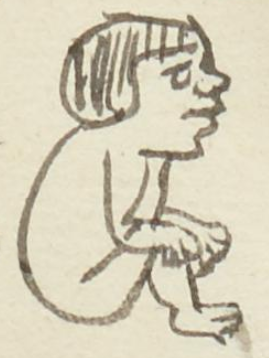Tlacatoncatl (MH641v)
This black-line drawing of the simplex glyph for the personal name or status, Tlacatoncatl ("Little Person"), attested here as a man's name, shows a person (tlacatl) seated and facing the viewer's right. The body--especially the lower half--is small, and it is naked, and almost a fetal position, suggesting vulnerability. Perhaps it is a baby or child, to convey the diminutive size. The -catl suffix (referring to a person with that characteristic or affiliation) is not shown visually.
Stephanie Wood
The affiliation suffix could suggest that this person belongs to a group of little people, people with the genetic or medical condition sometimes called "dwarfism" in English (which is an offensive term for many). Motecuhzoma II kept a group of little people for entertainment and for advice, because they were believed to have supernatural powers. (See Mexicolore article on the topic, which quotes a book by Mary Miller and Karl Taube.
Other disabilities can be found as personal name glyphs, such as Xonecuil and Chicol.
Stephanie Wood
tlacatōcatk
Tlacatoncatl
1560
Jeff Haskett-Wood
pequeño, diminutivo, small, niño, bebé, chico, enanos, enanas, nombres de hombres

tlaca(tl), person, https://nahuatl.wired-humanities.org/content/tlacatl
-tontli, small, little, https://nahuatl.wired-humanities.org/content/tontli
-catl, ethnicity, affiliation, or an indication of a title, https://nahuatl.wired-humanities.org/content/catl
Chiquillo
Stephanie Wood
Matrícula de Huexotzinco, folio 641v, World Digital Library, https://www.loc.gov/resource/gdcwdl.wdl_15282/?sp=365&st=image.
This manuscript is hosted by the Library of Congress and the World Digital Library; used here with the Creative Commons, “Attribution-NonCommercial-ShareAlike 3.0 License” (CC-BY-NC-SAq 3.0).


